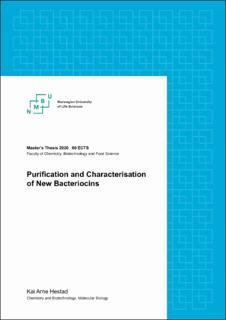| dc.contributor.advisor | Ovchinnikov, Kirill | |
| dc.contributor.advisor | Diep, Dzung Bao | |
| dc.contributor.author | Hestad, Kai Arne | |
| dc.date.accessioned | 2020-12-26T18:46:21Z | |
| dc.date.available | 2020-12-26T18:46:21Z | |
| dc.date.issued | 2020 | |
| dc.identifier.uri | https://hdl.handle.net/11250/2720987 | |
| dc.description.abstract | Not long after the discovery of the first antibiotics in the 20th century, bacteria resistant to this treatment has appeared and the spread of their genes can occur in several ways. This development has just increased, and costs associated with it will be very high in both health and economically. Among some emerging alternatives to antibiotics are antimicrobial peptides, some of which are classified as bacteriocins. These are ribosomally translated molecules that creates pores and permeabilises the membranes of other bacterial competitors in the same ecological niche.
In this project’s first part, discovery of the receptor used by the already isolated enterocin NKR 5-3B was attempted. Growth and purification of the bacteriocin was done by ammonium sulphate precipitation, cation exchange chromatography and reverse phase chromatography. A spot-on-lawn inhibition assay was done to obtain an inhibition spectrum, and to generate resistant bacterial colonies in the inhibition zones. The few resistant colonies were attempted to make isolates from, but this did not generate strains that had a genetic and stable basis. These were merely adaptive cells, meaning their resistance against NKR 5-3B was a change in the gene expression pattern, and not due to a mutation in the DNA that codes for NKR 5-3B receptors. Resistant mutants were thus not possible to generate, and a comparison between a wild type and resistant mutants to see what genes were missing in the latter, was barred. This indicates that NKR 5-3B, being a circular bacteriocin, might bind to target membranes without the need for a receptor.
The second part of the project aimed to screen for new bacteriocins from samples of raw milk. Several antimicrobial-producers were found and isolated by using layers of soft agar with samples and indicator separated. The producer strains were first subject to genetic analyses to identify species and genetic heterogeneity, and to identify bacteriocin genes. The two most active strains E. faecalis and S. uberis were characterised and E. faecalis produced enterolysin A. S. uberis had a high identity with a bacteriocin-like peptide, but later mass spectroscopy gave results indicating a mass of 2213.4 Dalton. This does not fit any known bacteriocin, but the inhibition profile against indicators show similarities with penocin A. The mass suggests something in the higher ranges of thiopeptides. Future work on this should include Edman degradation, in which the peptide is sequenced to know its identity. | en_US |
| dc.description.abstract | Ikke lenge etter funnet av de første antibiotika in det tyvende århundre begynte antibiotika-resistente bakterier å dukke opp, og deres gener kan spres på en rekke måter. Denne utviklingen har bare økt i hastighet, og kostnader assosiert med dette vil bli svært høyt både i helse og økonomisk. Blant alternativer til antibiotika er antimikrobielle peptider, hvor noen er klassifiserte som bakteriosiner. De er ribosomal translate molekyler som danner porer og permeabiliserer membranen til andre konkurrerende bakterier i samme økologiske nisje.
I første del av prosjektet er målet å oppdage reseptoren som bruker av den allerede isolerte bakteriestammen enterocin NKR 5-3B. Vekst og rensing av bakteriosinet ble utført med ammonium sulfat utfelling, kation-bytte kromatografi og omvendt-fase kromatografi. Spot-on-lawn assay ble utført for å se inhibisjonsspektrumet, og for å generere resistente bakteriekolonier i inhibisjonssonene. De få resistente coloniene ble forsøkt isolert og tested, men dette genererte ikke stammer med genetisk og stabilt basis for resistens. Disse var adaptive celler, hvor deres resistanse mot NKR 5-3B er en endring i genutrykk og ikke grunnet mutasjoner i DNA som koder for NKR 5-3B reseptorer. Resistente mutanter oppsto dermed ikke, og en sammenligning mellom villtypen og resistente mutanter for å identifisere manglende gener i mutantene, ble hindret. Dette indikerer at NKR 5-3B kanskje binder til målcellenes membran uten reseptorer, noe som sirkulære bakteriosiner kan gjøre.
Andre del av prosjektet tok sikte på å screene nye bakteriociner fra råmelkprøver. Flere antemikrobielle produsenter ble funnet og isolert med lag av soft agar som isolerte prøver og indikatoren. Produsentene ble så underlagt genetisk analyse for å identifisere arter og sjekke genetisk variasjon, samt identifisere bakteriosingener. De mest aktive stammene E. faecalis og S. uberis ble karakterisert, og E. faecalis produserte enterolysin A. S. uberis hadde stor likhet med et bakteriosin-lignende peptid, men senere massespektroskopi viste en masse på 2213.4 Dalton. Dette passer ikke med noen kjente bakteriosiner, men inhibisjonsprofilen viser likheter med pediojin eller penocin A. Massen indikerer noe i høyere størrelsesorden hos thiopeptider. Fremtidig arbeid på dette bør inkludere Edman degradering, hvor peptider blir sekvensert for avdekke dets sanne identitet. | en_US |
| dc.language.iso | eng | en_US |
| dc.publisher | Norwegian University of Life Sciences, Ås | en_US |
| dc.rights | Attribution-NonCommercial-NoDerivatives 4.0 Internasjonal | * |
| dc.rights.uri | http://creativecommons.org/licenses/by-nc-nd/4.0/deed.no | * |
| dc.title | Purification and characterisation of new bacteriocins | en_US |
| dc.title.alternative | Rensing og karakterisering av nye bakteriosiner | en_US |
| dc.type | Master thesis | en_US |
| dc.description.version | submittedVersion | en_US |
| dc.subject.nsi | VDP::Matematikk og Naturvitenskap: 400 | en_US |
| dc.source.pagenumber | 71 | en_US |
| dc.description.localcode | M-BIOTEK | en_US |

